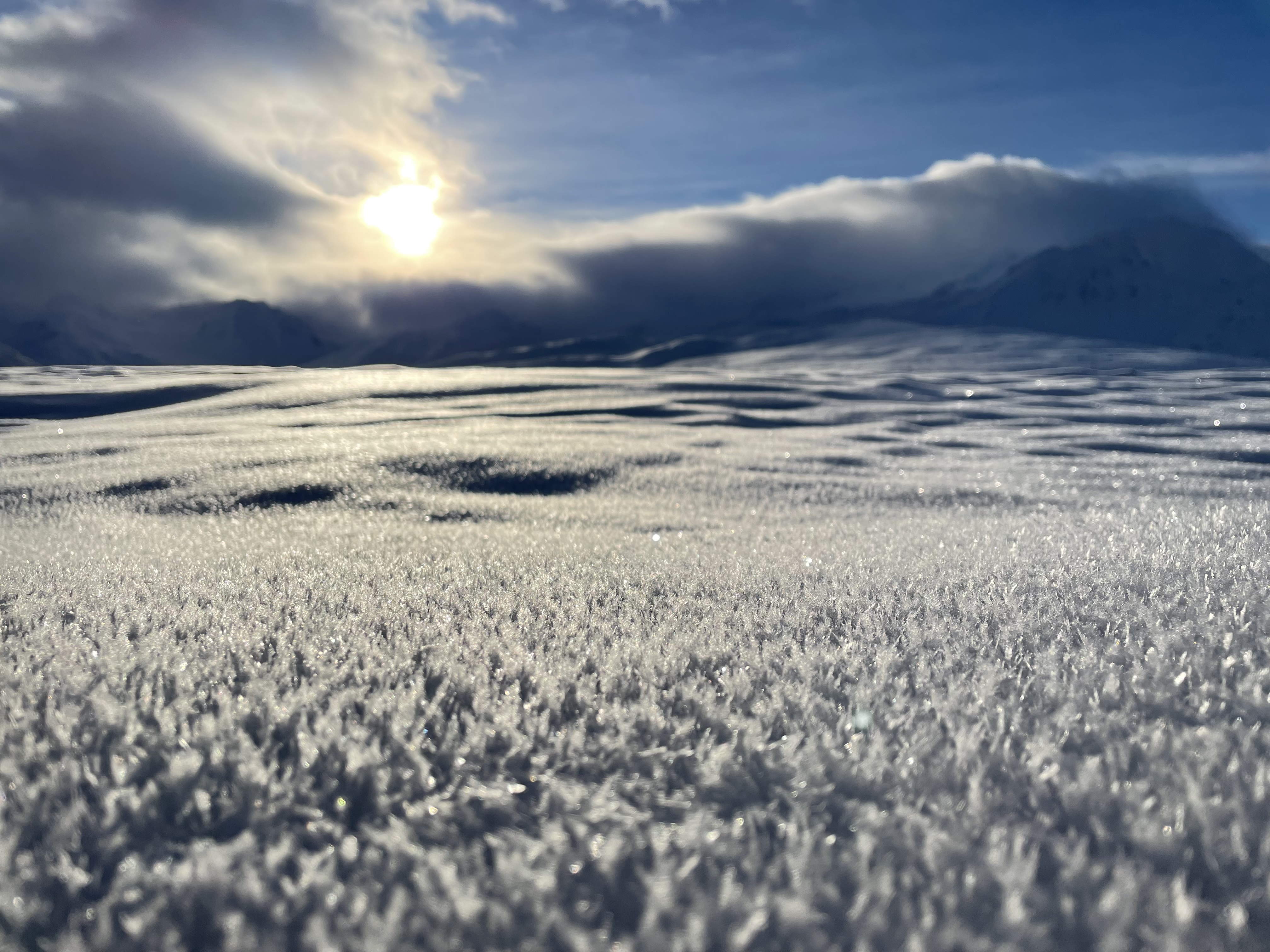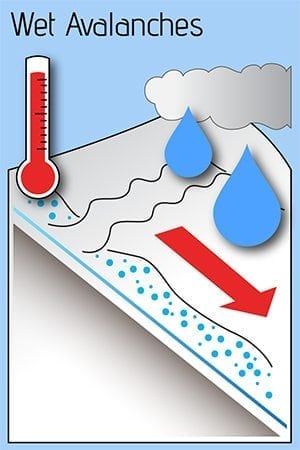Haines Avalanche Center
Above 2,500ftConsiderable
1,500 to 2,500ftConsiderable
Below 1,500ftConsiderable
Degrees of Avalanche Danger
Avalanche Problems
Problem 1
Aspect: All, especially N-NW-W aspects with SE winds
Elevation: Above ~1500′
Bottom Line: New storm snow totals of 10-14″ above ~1,500ft increase your chances of triggering an avalanche in the new snow on slopes greater than 30 degrees. Pockets of high danger can be found on freshly loaded N-NW-W slopes from moderate southeast winds gusting strong. Keep in mind the Jan. 20th surface hoar event that was buried under multiple feet of snow and strong southeast winds in the alpine, during the Atmospheric River event last weekend.
Travel Advice: Avoid wind loaded aspects! Look for blowing snow, shooting cracks, whumphing or collapsing that indicate a stiffer slab over weaker snow. Identify reactive storm snow using quick pits and test slopes to help gather information about the larger instabilities. Buried surface hoar layers are notoriously tricky to assess. Be cautious of slopes greater than 30 degrees, run-out zones and terrain traps. Careful snowpack evaluation, cautious route finding and conservative decision making are essential.
Photo below: Widespread surface hoar in the alpine on Flower Mountain, 1/20 (right before the last storm came in)

Likelihood:
- Almost Certain
- Very Likely
- Likely
- Possible
- Unlikely
Size:
- Historic
- Very Large
- Large
- Small
Trend
- Increasing
- Steady
- Decreasing
Problem 2
Aspect: All aspects
Elevation: Below freezing levels ~1500′
Freezing levels are somewhere around ~1,500ft and rain on snow below this elevation continues to severely weaken snow at the surface. At these lower elevations the snowpack is fully saturated and weak. Human triggered wet sluffs and slabs are likely today in steep terrain.
Travel Advice: Have you ever been caught in a wet sluff? Even small wet sluffs can be very heavy, and drag you down into a tree, a terrain trap, or over a cliff. Avoid slopes steeper than 30 degrees, especially if you find saturated snow more than ankle-deep. Stay out of gullies and other terrain traps, where wet slides and debris can come down from above and bury a person.
Likelihood:
- Almost Certain
- Very Likely
- Likely
- Possible
- Unlikely
Size:
- Historic
- Very Large
- Large
- Small
Trend
- Increasing
- Steady
- Decreasing
Avalanche Activity
01/15/2022 – An observation from Four Winds Mountain reported a collapse and a remote trigger of an approximately 200′ wide avalanche at 3,000′ on a northern aspect. It was estimated to run a couple hundred feet but low visibility kept observations to a minimum.
01/17/2022 – On solar aspects past Mosquito Lake and above Lutak Inlet small point releases were reported above treeline on steep alpine features.
01/22/2022 – A D3 wet slab avalanche was reported in the Chilkat Inlet with a starting zone around 2,000′ that entrained dirt and mud near Witches Tit. Numerous D2 storm snow slides were observed near Pyramid Harbor.
Weather
Forecast:
Snow levels should bounce around between 0 and 1,500ft Thursday-Saturday, as a new storm complex moves in. 18-36″ of new snow is likely above 1,500ft by Saturday night, with moderate SE winds. A brief cooling/drying trend is likely on Sunday.
Seasonal Summary:
- An Atmospheric river hit Jan 21-22. It brought in 2-7″ of SWE (2-5ft of snow above 2500ft, mostly rain below)
- Jan 9th-15th brought 24-48″ of new snow in the alpine, with some light rain up to 3,500ft, followed by heavier rain up to 2000ft.
- Very strong NW winds and arctic temperatures blasted the area the first week of January
- Jan 1st: New snow (20″ in Lutak, 7″ Transitional zone) buried any preserved surface hoar.
- Moderate NW winds hit exposed slopes Dec 19-20th
- Surface hoar formed on all aspects and elevations Dec 17-18th
- December brought in about 2-5 feet of snowfall (highest in Lutak zone), and a few strong NW wind events
- November brought consistent heavy snowfalls, cold weather, and SE winds
- October brought heavy snow in the alpine, followed by a few rain/sun crusts
| Snow Depth [in] | Last 24-hr Snow/SWE [in] | Last 3-days Snow/SWE [in] | Today’s Freezing Level [ft] | Today’s Winds | Next 24-hr Snow/SWE | |
| Mount Ripinsky @ treeline ** | 76″ | 5″ / 0.40 * | 3″ / 0.30* | 1500′ | mod, SE | 12″ / 0.90* |
| Flower Mountain @ treeline | 64″ | 4″ /0.30″ | 0″ /0.00″ | 1500′ | mod, SE | 8″ / 0.60 “ |
| Chilkat Pass @ 3,100ft | 23″ | 2″ / 0.10 | 0″ /0.00″ | 1500′ | mod, SE | 6″ / 0.45 * |
( *star means meteorological estimate )
** The Ripinsky weather station is in need of repair, and will likely be down until Summer.
Additional Information
Safe backcountry travel requires training and experience. You control your own risk by choosing where, when and how you travel. Ride rescue ready. Be prepared for an emergency. Prevent hypothermia. Carry bear spray. Winter is a high consequence environment.
Become a sustaining Haines Avalanche Center Member by clicking the poster or visiting dev.alaskasnow.org/joinHAC. Support local forecasts, observations, education and weather stations. Join a community of winter recreationalists. Benefit from collective knowledge and skills. Help keep your friends and family safe in the backcountry. Get a free limited edition mountain buff, or neck gaiter with a $50 membership (first 20 members!).
Practice like you play. Make sure all your rescue gear is fully functional and your beacon has NEW batteries. Make sure 1) everyone in the group has a functioning beacon, shovel and probe 2) knows how to use them and 3) has trained in companion rescue in the last year. Keep your skills fresh. If you head into the hills, watch out for red flag avalanche conditions, natural avalanches, whoomphing or collapsing, and shooting cracks.
Education Video Links:
- AIARE
- How to Practice Avalanche Rescue Snowmobile Edition: https://youtu.be/2ML499MMDfM
- AK Sled Shed Motorized Learning:
- Intro: https://youtu.be/aoagKHfGkxs
- Personal Electronics in Avalanche Terrain: https://youtu.be/2Vz9S0OEyFk
- Snowmobile Macgyver Tool Kit: https://youtu.be/4WBNu_t6Bbk
- Head and Face Protection: https://youtu.be/jIzW89wOyZI
- Pre-season prep: https://youtu.be/zJmrb8cZlR4
- My Transceiver: https://youtu.be/yblaDWP7Jf8
- BCA Avalanche Safety for Snowmobilers
- How to Fix Common Snowmobile Problems in the Field: https://youtu.be/g9fiTxEvuFk
- Sleducation: Avalanche Safety for Snowmobilers: https://youtu.be/EWFOd_9DYb8
- Intro to Avalanche Transceivers for Snowmobilers: https://youtu.be/6ZLSBmsceog
- Avalanche Transceiver Trailhead Test for Snowmobilers: https://youtu.be/rWoXbadFBsY
- Avalanche Transceiver Searching Use Snowmobiles: https://youtu.be/w1ucyI6LMXM
- BCA Avalanche Rescue Series
- Beacon Search 101: https://youtu.be/nnHXLVA2FcE
- Avalanche Probing 101: https://youtu.be/-0_yDN5Drzw
- Avalanche Shoveling 101: https://youtu.be/dGQg9o3vAkM
- Organizing a Backcountry Rescue: https://youtu.be/gywtmukgt8s
- Post Avalanche Patient Care: https://youtu.be/9FyIeUy4wpQ
- Backcountry Evacuation: https://youtu.be/WPF-dciefL8
- Complex Multiple Burials Backup Techniques: https://youtu.be/pB6AfY2KyYo
- National Avalanche Center
- Avalanche Problems Explained: https://youtu.be/DkbnT_9-cHU
- Intro to North American Avalanche Danger Scale: https://youtu.be/r_-KpOu7tbA
Announcements
Get the full forecast click Transitional or Lutak Zone below! Please submit your observations if you head out!


